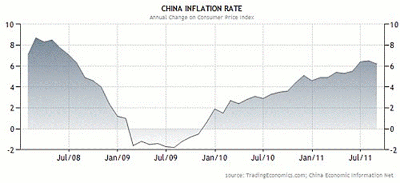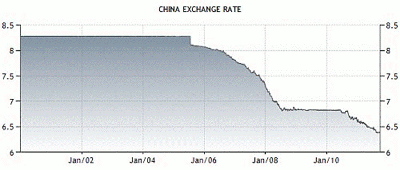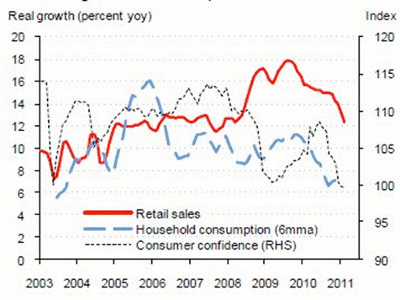China’s prescribed solution to its inflation problem is not working, which not only hurts the nation’s already sputtering economy, but also adversely impacts developed economies like the US and others.
There are plenty of risks out there to keep markets nervous right now. Two of the most visible are Europe in the short term, and China over the next six to 12 months.
China’s unsound monetary policy is causing problems.
Sure, the economy is booming—it grew 9.5% in the second quarter, which was better than expected—but with such low interest rates and banks still willing to lend, it should be booming.
The problem is the country’s foreign exchange (FX) reserves, which continue to soar.
China’s reserves increased $153 billion in the second quarter after jumping nearly $200 billion in the first quarter. China’s total FX reserves now stand at $3.2 trillion, equivalent to around 50% of GDP.
This is not a sign of strength, but of severe economic distortions.
As the Financial Times says:
“China must print renminbi to buy all the foreign exchange streaming into the country. To blunt the inflationary impact, it issues bonds and orders banks to set aside a chunk of their deposits as required reserves, but economists say that room for such sterilization operations is increasingly limited. That could put currency appreciation back to the forefront of efforts to damp down on inflation.”
China has an inflation problem.
This is because of its extraordinarily loose monetary policy. But it has been reluctant to do what’s necessary to control inflation. Instead, it increases reserve requirements and slowly increases interest rates. As you can see from this chart, these moves have little impact on the problem.
China’s inflation is primarily a result of it wanting to maintain a cheap currency.
NEXT: Why China's Exchange Rate Policy Is Flawed
|pagebreak|In order for China to maintain a fixed exchange rate, it must print money to buy the foreign exchange flowing into the country. The more FX reserves that flow in each month, the more money printing must take place. This in turn makes it increasingly difficult to control inflation.
Back in July, I wrote in Sound Money. Sound Investments that China’s inflation problem and its policy prescriptions will come under greater scrutiny in the second half of this year. This week, the US Senate voted to “Move ahead with a bill that would punish China for keeping the value of its currency low,’ reported The Wall Street Journal.
The undervalued yuan makes imported products cheaper for American consumers, but politicians, like Republican Presidential candidate Mitt Romney, are claiming this hurts American jobs.
Yet the response from the People’s Bank of China said “…factoring in inflation, the yuan has appreciated greatly and is close to a balanced level.”
In September of this year, Prime Minister Wen said “China will continue to follow the strategy of expanding domestic demand, with a focus on improving the structure of demand and increasing consumer demand to drive economic growth.”
But this will only happen with a stronger Chinese currency.
The People’s Daily Online, a Chinese newspaper, has reported analysts asking for an increase in the yuan to ease the inflationary pressures and drive consumer demand.
Maintaining a low yuan discourages consumption, and consumption growth is slowing to pre-crisis levels.
China’s cheap yuan policy is punishing the household sector.
Simply put, the weak yuan benefits only those companies in the export sector and those with fixed-asset investments. The country’s high household saving rate is effectively subsidizing these sectors.
Keeping the yuan undervalued will make a transition to a consumer-based economy near impossible.
So for those in the Chinese government who expect its citizens to rise and become a major source of global consumer demand, think again.
China is a distorted economy reliant on fixed-asset investment and exports. Adjusting from such a model won’t be the end of the world, but it will be painful. And I suspect it will mean the Australian and US markets will remain volatile for some time.
By Greg Canavan of Money Morning Australia and Counting Pips
























